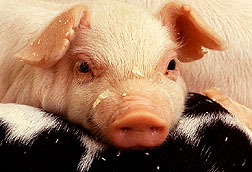
Baby piglet. Photo by Scott Bauer
Livestock producers lose more animals or see feed efficiency or market weight decline when animals are under stress.
Now it appears that stress causes some livestock—cattle and hogs in this study—to produce calming brain compounds called cannabinoids.
Scientists at an Agricultural Research Service lab in West Lafayette, Indiana, are conducting studies to measure how these compounds influence livestock behavior.
They say mixing pigs into new social groups and other common on-farm practices actually activate the cannabinoid pathway in pigs. This shows the animal can turn the cannabinoid system on and off during stressful situations.
Gary Weesner, an animal physiologist with the lab, has studied the cannabinoid pathway in pigs and cloned DNA associated with cannabinoid receptors, enabling researchers to track the activity of the chemical.
“We can’t measure the cannabinoids in the animal itself,” Weesner says, “but we can detect the receptors. At present, they’re the only part of the cannabinoid pathway that we can check. We do not yet have the ability to measure natural levels of cannabinoids.
“Cannabinoid receptors function like doors on cells that open to let in certain compounds that activate the cells,” says Weesner. “These receptors are on cells only in certain areas of the brain—including those associated with pain and pleasure.”
To study how cannabinoids affect animals under stress, Weesner compared the level of cannabinoid receptors found in the brains of two separate groups of pigs. He selected 10 boars—uncastrated male pigs—and subjected one group of 5 to a series of stresses typical in farm settings. These pigs were run through a series of gates and pens, in a simulated shipping exercise, and then mixed with other boars.
“We selected boars because they are aggressive by nature,” Weesner says. At the conclusion of the experiment, the level of cannabinoid receptors in the pigs’ brains was analyzed. The second group of pigs was not moved or mixed with other pigs.
Scientists found a significant increase in the number of cannabinoid receptors in the group of pigs subjected to the moving and regrouping exercise compared to the control group.
“We confirmed the cannabinoid pathway is being activated,” Weesner says. “If animals remained stressed for longer than 30 minutes we noticed the numbers of cannabinoid receptors remained higher.”
Weesner explains the next step is to determine how cannabinoids affect the immune system in animals and to determine if the activation of the cannabinoid pathway has a positive or negative impact on animal health.
Scientists may be able to use that information to help producers refine livestock management practices. — By Dawn Lyons-Johnson, ARS.
USDA-ARS Livestock Behavior Research Unit, Purdue University, 1026 Poultry Science Bldg., West Lafayette, IN 47907-1026; phone (765) 494-6938


